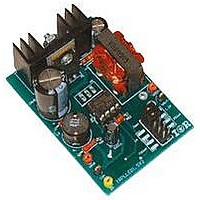IRPLLED1 International Rectifier, IRPLLED1 Datasheet - Page 18

IRPLLED1
Manufacturer Part Number
IRPLLED1
Description
BOARD EVALUATION FOR IRS2540PBF
Manufacturer
International Rectifier
Specifications of IRPLLED1
Current - Output / Channel
1.5A
Outputs And Type
1, Non-Isolated
Voltage - Output
24V
Features
Dimmable
Voltage - Input
50 ~ 170V
Utilized Ic / Part
IRS2540PBF
Core Chip
IRS2540, IRS2541, IRS25401
Topology
Buck (Step Down)
No. Of Outputs
1
Output Current
1.5A
Output Voltage
500mV
Dimming Control Type
PWM
Development Tool Type
Hardware - Eval/Demo Board
Lead Free Status / RoHS Status
Contains lead / RoHS compliant by exemption
The bootstrap diode should be a fast recovery, if not an ultrafast recovery component to maintain good efficiency.
Since the cathode of the bootstrap diode will be switching between COM and VBUS + 14V, the reverse recovery
time of this diode is of critical importance. For additional information concerning the bootstrap components, refer to
the Design Tip (DT 98-2), “Bootstrap Component Selection For Control ICs” at
Support.
The enable pin can be used for dimming or open-circuit protection. When the ENN pin is held low the IRS2540
remains in a fully functional state with no alterations to the operating environment. To disable the control feedback
and regulation a voltage greater than VENTH (approximately 2.5V) needs to be applied to the ENN pin. With the
chip in a disabled state the HO output will remain low and the LO output will remain high to prevent VS from
floating, in addition to maintaining charge on the bootstrap capacitor if a MOSFET is used for the lower switch.
The threshold for disabling the IRS2540/1/01/11 has been set to 2.5V to enhance immunity to any externally
generated noise or application ground noise and also makes it possible receive a drive signal from a microcontroller.
Dimming Mode
To achieve dimming a signal with constant frequency and set duty cycle can be fed into the ENN pin. There is a
direct linear relationship between the average load current and duty cycle if no output capacitor is used in the circuit.
A large output capacitor tends to increase the minimum dim level because some current continues to supply the
LEDs from this capacitor during the off phase of the PWM dimming. With no output capacitor, if the ratio is 50%
then 50% of the maximum set light output will be emitted. Similarly if the ratio is 30% then 70% of the maximum
set light output will be realized. A sufficiently high frequency of the dimming signal must be chosen to avoid
visible flashing or “strobe light” effect. A signal around 1kHz from zero to 5V is recommended. For this evaluation
board, a fully adjustable (0% to 100% duty cycle) PWM wave generator is suggested but this is not included as part
of the evaluation board. The following circuit is a simple enable pin dimming signal generator.
If an external supply for VCC is used, the minimum amount of dimming achievable (light output approaches 0%)
will be determined by the “on” time of the HO output, when in a fully functional regulating state. To maintain
reliable dimming, it is recommended to keep the “off” time of the enable signal at least 10 times that of the HO “on”
time. For example, if the application is running at 75kHz with an input voltage of 100V and an output voltage of
20V, the HO “on” time will be 2.7µs (one-fourth of the period – see calculations below) according to standard buck
topology theory. This will set the minimum “off” time of the enable signal to 27µs.
www.irf.com
8. Enable Pin
Fig. 22 Suggested PWM Driver (not included in IRPLLED1.5X2)
COM
VBUS
C2
C1
R1
R3
R7
RD-0608
R4
R2
IN1(+)
GND
OUT1
IN1(-)
1
2
3
4
IC2
8
7
6
5
VCC
OUT2
IN2(-)
IN2(+)
R6
CVCC4
R5
VR1
CVCC3
DEN2
RS
ENN pin
Out to
www.irf.com
under Design
18











